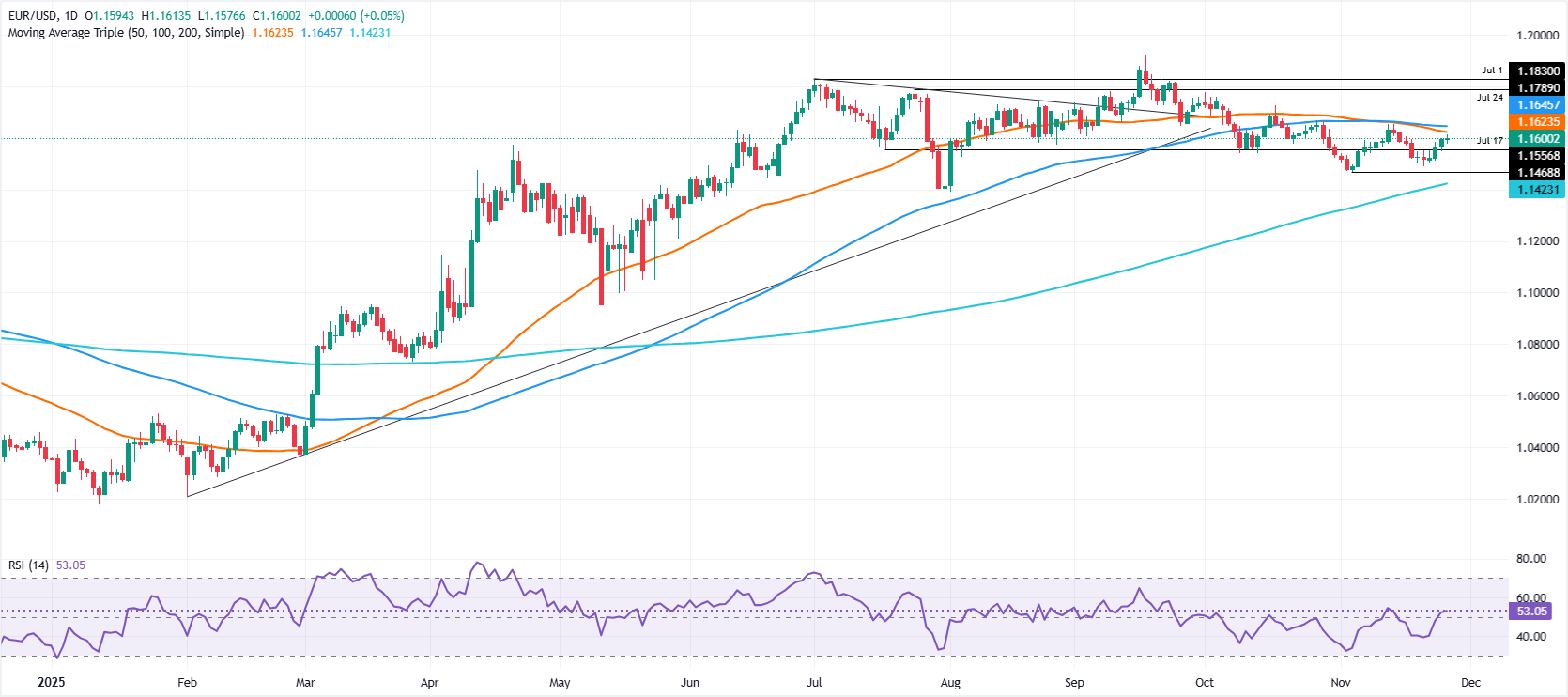EUR/USD steady around 1.1600 as subdued trade highlights Dollar pressure

- EUR/USD steady as soft US inflation, weak retail sales, and fading confidence boost Fed cut expectations.
- FedWatch shows 85% odds of a 25-bps cut, though firm jobless claims limit full dovish tilt.
- Eurozone consumer confidence improves slightly, while ECB officials stay cautious despite brighter household sentiment.
EUR/USD is flat on Thursday amid thin trading liquidity conditions as US markets are closed for Thanksgiving. Still expectations that the Federal Reserve might reduce borrowing costs keep the Greenback pressured, with the Euro poised to end the week with gains. The pair trades at 1.1596.
Euro steadies in quiet Thanksgiving session, supported by rising expectations of a December Fed rate cut
With no major US economic events on Thursday, recent inflation figures, weaker retail sales, and declining consumer confidence are increasing pressure on the Fed. According to the CME FedWatch Tool, there is an 85% chance of a 25-basis point rate cut.
The odds rose as Federal Reserve officials turned dovish, led by the New York Fed President John Williams, last week. However, the latest Initial Jobless Claims report for the week ending November 21, surprised the markets as the number of Americans filling for unemployment insurance, dipped below estimates and the previous print.
Across the pond, the Eurozone economic docker features Consumer Confidence improved slightly with households showing willingness to spend ahead of the upcoming Christmas season.
European Central Bank (ECB) officials remained dovish, with ECB Kazaks saying that is not the time to cut rates.
Daily market movers: Euro poised to extend gains amid Dollar weakness
- The Eurozone Consumer Confidence hit an eight-month high at -14.2 in November, unchanged from October. The survey showed higher confidence in services, retail trade and construction, which was partially offset by the weakness in industry.
- Economic data in the US continues to flow yet dovish comments by Fed officials are driving EUR/USD’s price action. The number of Americans filling for jobless insurance decreased compared to the November’s 14 print, reaffirmation of the low-firing low-hiring environment, expressed by several Fed policymakers.
- The US Dollar Index (DXY). which tracks the buck’s performance versus six currencies, is flat at 99.57.
Technical Outlook: EUR/USD subdued around 1.1600 waiting for catalyst
EUR/USD trades sideways, with buyers unable to decisively break above the 1.1600 mark, to extend its advance past the confluence of the 50- and 100-day Simple Moving Averages (SMA) near 1.1620/1.1646. Momentum remains mildly bullish, shows the Relative Strength Index (RSI), but the indicator has flattened, signaling that consolidation is likely to persist in the near term.
A breakout above the confluence of the 50- and 100-day Simple Moving Averages, exposes 1.1650, which once cleared, opens the way to challenge the 1.1700 handle.
On the downside, a drop below 1.1550 would open the door toward 1.1500. Further weakness would expose the November 5 low at 1.1468, followed by the 200-day SMA near 1.1426.

Euro FAQs
The Euro is the currency for the 20 European Union countries that belong to the Eurozone. It is the second most heavily traded currency in the world behind the US Dollar. In 2022, it accounted for 31% of all foreign exchange transactions, with an average daily turnover of over $2.2 trillion a day. EUR/USD is the most heavily traded currency pair in the world, accounting for an estimated 30% off all transactions, followed by EUR/JPY (4%), EUR/GBP (3%) and EUR/AUD (2%).
The European Central Bank (ECB) in Frankfurt, Germany, is the reserve bank for the Eurozone. The ECB sets interest rates and manages monetary policy. The ECB’s primary mandate is to maintain price stability, which means either controlling inflation or stimulating growth. Its primary tool is the raising or lowering of interest rates. Relatively high interest rates – or the expectation of higher rates – will usually benefit the Euro and vice versa. The ECB Governing Council makes monetary policy decisions at meetings held eight times a year. Decisions are made by heads of the Eurozone national banks and six permanent members, including the President of the ECB, Christine Lagarde.
Eurozone inflation data, measured by the Harmonized Index of Consumer Prices (HICP), is an important econometric for the Euro. If inflation rises more than expected, especially if above the ECB’s 2% target, it obliges the ECB to raise interest rates to bring it back under control. Relatively high interest rates compared to its counterparts will usually benefit the Euro, as it makes the region more attractive as a place for global investors to park their money.
Data releases gauge the health of the economy and can impact on the Euro. Indicators such as GDP, Manufacturing and Services PMIs, employment, and consumer sentiment surveys can all influence the direction of the single currency. A strong economy is good for the Euro. Not only does it attract more foreign investment but it may encourage the ECB to put up interest rates, which will directly strengthen the Euro. Otherwise, if economic data is weak, the Euro is likely to fall. Economic data for the four largest economies in the euro area (Germany, France, Italy and Spain) are especially significant, as they account for 75% of the Eurozone’s economy.
Another significant data release for the Euro is the Trade Balance. This indicator measures the difference between what a country earns from its exports and what it spends on imports over a given period. If a country produces highly sought after exports then its currency will gain in value purely from the extra demand created from foreign buyers seeking to purchase these goods. Therefore, a positive net Trade Balance strengthens a currency and vice versa for a negative balance.







